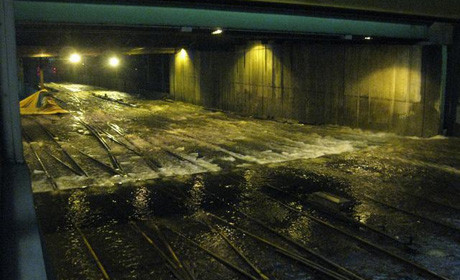Hurricane Sandy presented a challenge to journalists using social media channels: how can you be sure that the content you are seeing is accurate?
Storyful, an organisation that specialises in finding verifiable news on social media, hosted a Google+ Hangout yesterday on verification during Hurricane Sandy.
The guests were Adam Blenford, the online news editor at BBC News; Liz Heron, social media director at the Wall Street Journal; Aine Kerr, the US politics director at Storyful; Tom Phillips, the international editor at MSN, Craig Silverman, who writes the Regret the Error blog at Poynter; Paul Watson, chief technical officer at Storyful and a group of students from Griffith College Dublin.
Journalism.co.uk was listening in. Here are four main points that came out of the discussion:
1. Users care about the accuracy of the information they receive from news organisations.
Adam Blenford said: “If they don’t think they’re worried about verification per se as a concept, they’re worried about the trustworthiness of the organisations that they’re using to get their news from.”
Liz Heron said every time the Wall Street Journal posts a photo on Facebook – which will have first been verified by the news outlet – users will still question the authenticity of the image, even if taken by a professional photographer.
“There’s such high suspicion now among our readers and viewers that I think it’s really important, especially in a situation like covering Sandy, to be really obvious and clear about the fact that this has been verified. There’s huge suspicion out there about this kind of stuff, even for professional photography,” she said.
2. To get people interested in the verification process, it has to be as compelling as the fake content.
Craig Silverman mentioned The Atlantic, which embedded a “verdict” on images, and Buzzfeed, which put together a quiz on real and fake images, as examples of organisations that had done something a bit different with their verification processes.
“This is content people are really interested in, it’s useful to them but there are also ways to make it fun and interesting. I think that’s actually been very key to helping the real images or at least the verdict on the fake ones spread,” he said.
Tom Phillips agreed, saying there is a “need to make the verification process as compelling in terms of content as the thing it’s verifying, because if we’re not doing that then it’s going to get lost.”
3. Journalists should be wary of broadcasting debunked fake content because there is a risk users may misinterpret it as genuine.
Craig Silverman added: “The risk that is always there, however, [is] that when you actually put that tweet out there, even if you’re noting it as false, there are people who are still going to read it and who then may actually retweet it without that context of saying it’s false”.
4. A few fundamental journalistic principles can help ensure you are not fooled by fake content.
Liz Heron gave the example of using the live video stream of the New York Stock Exchange, which proved that the rumour it was under three feet of water was untrue. She added that often the simplest way to verify something was to contact the original source directly.
Adam Blenford also added that “it appears that the closer and more finely-tuned your Twitter lists and your Twitter stream was towards New York on the night of the storm, the less likely you were to get hoaxed”.
“That’s the old adage if you can get closer to the story, you’re more likely to get it right.”
In other news…
While on the subject of social media sharing, Twitter stated on Sunday (9 December) that Instagram photos would no longer appear integrated on the platform. Tweets will instead only link to an Instagram picture. In a statement published by the BBC, Instagram chief executive Kevin Systrom said it was felt that “the best experience is for us to link back to where the content lives”.
Markham Nolan, managing editor at Storyful, told Journalism.co.uk this was an “inconvenience” for journalists specialising in verification.
“It was very easy to click in and out, have a quick glance and do the initial check,” he said.
But he added that he did not think it would “slow down the deeper verification”.
“It just means you have to click out of your Twitter stream every time you want to see an Instagram picture to see if it’s useful or see if it’s something worth verifying,” he added.
